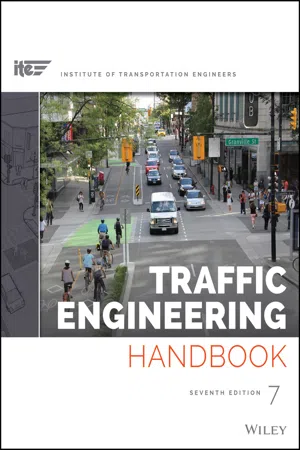
- English
- PDF
- Available on iOS & Android
Traffic Engineering Handbook
About This Book
Get a complete look into modern traffic engineering solutions
Traffic Engineering Handbook, Seventh Edition is a newly revised text that builds upon the reputation as the go-to source of essential traffic engineering solutions that this book has maintained for the past 70 years. The updated content reflects changes in key industry standards, and shines a spotlight on the needs of all users, the design of context-sensitive roadways, and the development of more sustainable transportation solutions. Additionally, this resource features a new organizational structure that promotes a more functionally-driven, multimodal approach to planning, designing, and implementing transportation solutions.
A branch of civil engineering, traffic engineering concerns the safe and efficient movement of people and goods along roadways. Traffic flow, road geometry, sidewalks, crosswalks, cycle facilities, shared lane markings, traffic signs, traffic lights, and more—all of these elements must be considered when designing public and private sector transportation solutions.
- Explore the fundamental concepts of traffic engineering as they relate to operation, design, and management
- Access updated content that reflects changes in key industry-leading resources, such as the Highway Capacity Manual (HCM), Manual on Uniform Traffic Control Devices (MUTCD), AASSHTO Policy on Geometric Design, Highway Safety Manual (HSM), and Americans with Disabilities Act
- Understand the current state of the traffic engineering field
- Leverage revised information that homes in on the key topics most relevant to traffic engineering in today's world, such as context-sensitive roadways and sustainable transportation solutions
Traffic Engineering Handbook, Seventh Edition is an essential text for public and private sector transportation practitioners, transportation decision makers, public officials, and even upper-level undergraduate and graduate students who are studying transportation engineering.
Frequently asked questions
Information
Table of contents
- Cover
- Title Page
- Copyright
- Table of Contents
- Preface
- Acknowledgments
- Chapter 1 Introduction to the Traffic Engineering Handbook and Its Role in Evolving Practice
- Chapter 2 Probability and Statistical Analyses Techniques for Traffic Engineering Performance Measurement
- Chapter 3 Road Users
- Chapter 4 Traffic Engineering Studies
- Chapter 5 Level of Service Concepts in Multimodal Environments
- Chapter 6 Forecasting Travel Demand
- Chapter 7 Traffic Flow Characteristics for Uninterrupted-Flow Facilities
- Chapter 8 Design and Operations of Road Segments and Interchanges in Rural Areas
- Chapter 9 Planning, Design, and Operations of Road Segments and Interchanges in Urban Areas
- Chapter 10 Design and Control for Interrupted Traffic Flow through Intersections
- Chapter 11 Design and Operation of Complete Streets and Intersections
- Chapter 12 Access Management
- Chapter 13 Parking
- Chapter 14 Traffic Calming
- Chapter 15 Work Zone Maintenance of Traffic and Construction Staging
- Chapter 16 Traffic Management for Planned, Unplanned, and Emergency Events
- Index
- EULA